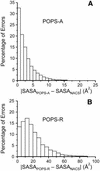Parameter optimized surfaces (POPS): analysis of key interactions and conformational changes in the ribosome
- PMID: 12087181
- PMCID: PMC117037
- DOI: 10.1093/nar/gkf373
Parameter optimized surfaces (POPS): analysis of key interactions and conformational changes in the ribosome
Abstract
We present a new method for the calculation of solvent accessible surface areas at the atomic and residue levels, which we call parameter optimized surfaces (POPS-A and POPS-R ). Atomic and residue areas (the latter simulated with a single sphere centered at the C(alpha)s atom for amino acids and at the P atom for nucleotides) have been optimized versus accurate all-atoms methods. We concentrated on an analytical formula for the approximation of solvent accessibilities. The formula is simple, easily derivable and fast to compute, therefore it is practical for use in molecular dynamics simulations as an approximation to the first solvation shell. The residue based approach POPS-R has been derived as a useful tool for the analysis of large macromolecular assemblies like the ribosome, and is especially suited for use in refinement of low resolution structures. The structures of the 70S, 50S and 30S ribosomes have been analyzed in detail and most of the interactions within the subunits and at their interfaces were clearly identified. Some interesting differences between 30S alone and within the 70S have been highlighted. Owing to the presence of the P-tRNA in the 70S ribosome, localized conformational rearrangements occur within the subunits, exposing Arg and Lys residues to negatively charged binding sites of P-tRNA. POPS-R also allows for estimates of the loss of free energy of solvation upon complex formation, particularly useful in designing new protein-RNA complexes and in suggesting more focused experimental work.
Figures





Similar articles
-
POPS: A fast algorithm for solvent accessible surface areas at atomic and residue level.Nucleic Acids Res. 2003 Jul 1;31(13):3364-6. doi: 10.1093/nar/gkg601. Nucleic Acids Res. 2003. PMID: 12824328 Free PMC article.
-
Crystal structure of a 70S ribosome-tRNA complex reveals functional interactions and rearrangements.Cell. 2006 Sep 22;126(6):1065-77. doi: 10.1016/j.cell.2006.08.032. Epub 2006 Sep 7. Cell. 2006. PMID: 16962654
-
Atomic model of the Thermus thermophilus 70S ribosome developed in silico.Biophys J. 2004 Oct;87(4):2714-22. doi: 10.1529/biophysj.104.040162. Biophys J. 2004. PMID: 15454463 Free PMC article.
-
The 30S ribosomal P site: a function of 16S rRNA.FEBS Lett. 2005 Feb 7;579(4):855-8. doi: 10.1016/j.febslet.2004.11.026. FEBS Lett. 2005. PMID: 15680962 Review.
-
Cryo-electron microscopy as an investigative tool: the ribosome as an example.Bioessays. 2001 Aug;23(8):725-32. doi: 10.1002/bies.1102. Bioessays. 2001. PMID: 11494321 Review.
Cited by
-
Implicit Solvation Parameters Derived from Explicit Water Forces in Large-Scale Molecular Dynamics Simulations.J Chem Theory Comput. 2012 Jul 10;8(7):2391-2403. doi: 10.1021/ct200390j. Epub 2012 Jun 12. J Chem Theory Comput. 2012. PMID: 23180979 Free PMC article.
-
Putative role of invariant water molecules in the X-ray structures of family G fungal endoxylanases.J Biosci. 2018 Jun;43(2):339-349. J Biosci. 2018. PMID: 29872022
-
Combinatorial complexity and compositional drift in protein interaction networks.PLoS One. 2012;7(3):e32032. doi: 10.1371/journal.pone.0032032. Epub 2012 Mar 8. PLoS One. 2012. PMID: 22412851 Free PMC article.
-
Solution structure of an informationally complex high-affinity RNA aptamer to GTP.RNA. 2006 Apr;12(4):567-79. doi: 10.1261/rna.2251306. Epub 2006 Feb 28. RNA. 2006. PMID: 16510427 Free PMC article.
-
Zinc finger oxidation of Fpg/Nei DNA glycosylases by 2-thioxanthine: biochemical and X-ray structural characterization.Nucleic Acids Res. 2014;42(16):10748-61. doi: 10.1093/nar/gku613. Epub 2014 Aug 20. Nucleic Acids Res. 2014. PMID: 25143530 Free PMC article.
References
-
- International Human Genome Sequencing Consortium (2001) Initial sequencing and analysis of the human genome. Nature, 409, 860–921. - PubMed
-
- Doudna J. (2000) Structural genomics of DNA. Nature Struct. Biol., Suppl 7, 954–956. - PubMed
-
- Marcotte E., Pellegrini,M., Thompson,M., Yeates,T. and Eisenberg,D. (1999) A combined algorithm for genome-wide prediction of protein function. Nature, 402, 83–86. - PubMed
-
- Thornton J., Todd,A., Milburn,D., Borkakoti,N. and Orengo,C. (2000) From structure to function: approaches and limitations. Nature Struct. Biol., Suppl 7, 991–994. - PubMed
MeSH terms
Substances
LinkOut - more resources
Full Text Sources
Other Literature Sources
Miscellaneous

